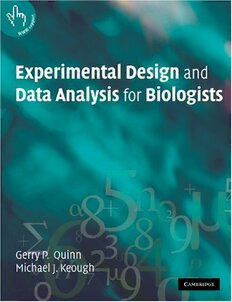Table Of ContentThis page intentionally left blank
Experimental Design and DataAnalysis for Biologists
Anessentialtextbookforanystudentorresearcherin Gerry Quinn is in the School of Biological
biology needing to design experiments, sampling Sciences at Monash University, with research inter-
programs or analyze the resulting data. The text ests in marine and freshwater ecology, especially
beginswitharevisionofestimationandhypothesis riverfloodplainsandtheirassociatedwetlands.
testingmethods,coveringbothclassicalandBayesian
philosophies, before advancing to the analysis of Michael KeoughisintheDepartmentofZoology
linearandgeneralizedlinearmodels.Topicscovered attheUniversityofMelbourne,withresearchinter-
include linear and logistic regression, simple and ests in marine ecology, environmental science and
complexANOVAmodels(forfactorial,nested,block, conservationbiology.
split-plot and repeated measures and covariance
designs), and log-linear models. Multivariate tech- Both authors have extensive experience teaching
niques, including classification and ordination, are experimentaldesignandanalysiscoursesandhave
then introduced. Special emphasis is placed on provided advice on the design and analysis of sam-
checkingassumptions,exploratorydataanalysisand pling and experimental programs in ecology and
presentationofresults.Themainanalysesareillus- environmentalmonitoringtoawiderangeofenvi-
trated with many examples from published papers ronmental consultants, university and government
and there is an extensive reference list to both the scientists.
statisticalandbiologicalliterature.Thebookissup-
portedbyawebsitethatprovidesalldatasets,ques-
tionsforeachchapterandlinkstosoftware.
Experimental Design and Data
Analysis for Biologists
Gerry P.Quinn
MonashUniversity
Michael J.Keough
UniversityofMelbourne
Cambridge, New York, Melbourne, Madrid, Cape Town, Singapore, São Paulo
Cambridge University Press
The Edinburgh Building, Cambridge , United Kingdom
Published in the United States of America by Cambridge University Press, New York
www.cambridge.org
Information on this title: www.cambridge.org/9780521811286
© G. Quinn & M. Keough 2002
This book is in copyright. Subject to statutory exception and to the provision of
relevant collective licensing agreements, no reproduction of any part may take place
without the written permission of Cambridge University Press.
First published in print format 2002
- ----
eBook (NetLibrary)
- ---
eBook (NetLibrary)
- ----
hardback
- ---
hardback
- ----
paperback
- ---
paperback
Cambridge University Press has no responsibility for the persistence or accuracy of
s for external or third-party internet websites referred to in this book, and does not
guarantee that any content on such websites is, or will remain, accurate or appropriate.
Contents
Preface pagexv
1 Introduction 1
1.1 Scientificmethod 1
1.1.1 Patterndescription 2
1.1.2 Models 2
1.1.3 Hypothesesandtests 3
1.1.4 Alternativestofalsification 4
1.1.5 Roleofstatisticalanalysis 5
1.2 Experimentsandothertests 5
1.3 Data,observationsandvariables 7
1.4 Probability 7
1.5 Probabilitydistributions 9
1.5.1 Distributionsforvariables 10
1.5.2 Distributionsforstatistics 12
2 Estimation 14
2.1 Samplesandpopulations 14
2.2 Commonparametersandstatistics 15
2.2.1 Center(location)ofdistribution 15
2.2.2 Spreadorvariability 16
2.3 Standarderrorsandconfidenceintervalsforthemean 17
2.3.1 NormaldistributionsandtheCentralLimitTheorem 17
2.3.2 Standarderrorofthesamplemean 18
2.3.3 Confidenceintervalsforpopulationmean 19
2.3.4 Interpretationofconfidenceintervalsforpopulationmean 20
2.3.5 Standarderrorsforotherstatistics 20
2.4 Methodsforestimatingparameters 23
2.4.1 Maximumlikelihood(ML) 23
2.4.2 Ordinaryleastsquares(OLS) 24
2.4.3 MLvsOLSestimation 25
2.5 Resamplingmethodsforestimation 25
2.5.1 Bootstrap 25
2.5.2 Jackknife 26
2.6 Bayesianinference–estimation 27
2.6.1 Bayesianestimation 27
2.6.2 Priorknowledgeandprobability 28
2.6.3 Likelihoodfunction 28
2.6.4 Posteriorprobability 28
2.6.5 Examples 29
2.6.6 Othercomments 29
vi CONTENTS
3 Hypothesis testing 32
3.1 Statisticalhypothesistesting 32
3.1.1 Classicalstatisticalhypothesistesting 32
3.1.2 AssociatedprobabilityandTypeIerror 34
3.1.3 Hypothesistestsforasinglepopulation 35
3.1.4 One-andtwo-tailedtests 37
3.1.5 Hypothesesfortwopopulations 37
3.1.6 Parametrictestsandtheirassumptions 39
3.2 Decisionerrors 42
3.2.1 TypeIandIIerrors 42
3.2.2 Asymmetryandscalabledecisioncriteria 44
3.3 Othertestingmethods 45
3.3.1 Robustparametrictests 45
3.3.2 Randomization(permutation)tests 45
3.3.3 Rank-basednon-parametrictests 46
3.4 Multipletesting 48
3.4.1 Theproblem 48
3.4.2 Adjustingsignificancelevelsand/orPvalues 49
3.5 Combiningresultsfromstatisticaltests 50
3.5.1 CombiningPvalues 50
3.5.2 Meta-analysis 50
3.6 Critiqueofstatisticalhypothesistesting 51
3.6.1 Dependenceonsamplesizeandstoppingrules 51
3.6.2 Samplespace–relevanceofdatanotobserved 52
3.6.3 Pvaluesasmeasureofevidence 53
3.6.4 Nullhypothesisalwaysfalse 53
3.6.5 Arbitrarysignificancelevels 53
3.6.6 Alternativestostatisticalhypothesistesting 53
3.7 Bayesianhypothesistesting 54
4 Graphical exploration of data 58
4.1 Exploratorydataanalysis 58
4.1.1 Exploringsamples 58
4.2 Analysiswithgraphs 62
4.2.1 Assumptionsofparametriclinearmodels 62
4.3 Transformingdata 64
4.3.1 Transformationsanddistributionalassumptions 65
4.3.2 Transformationsandlinearity 67
4.3.3 Transformationsandadditivity 67
4.4 Standardizations 67
4.5 Outliers 68
4.6 Censoredandmissingdata 68
4.6.1 Missingdata 68
4.6.2 Censored(truncated)data 69
4.7 Generalissuesandhintsforanalysis 71
4.7.1 Generalissues 71
CONTENTS vii
5 Correlation and regression 72
5.1 Correlationanalysis 72
5.1.1 Parametriccorrelationmodel 72
5.1.2 Robustcorrelation 76
5.1.3 Parametricandnon-parametricconfidenceregions 76
5.2 Linearmodels 77
5.3 Linearregressionanalysis 78
5.3.1 Simple(bivariate)linearregression 78
5.3.2 Linearmodelforregression 80
5.3.3 Estimatingmodelparameters 85
5.3.4 Analysisofvariance 88
5.3.5 Nullhypothesesinregression 89
5.3.6 Comparingregressionmodels 90
5.3.7 Varianceexplained 91
5.3.8 Assumptionsofregressionanalysis 92
5.3.9 Regressiondiagnostics 94
5.3.10 Diagnosticgraphics 96
5.3.11 Transformations 98
5.3.12 Regressionthroughtheorigin 98
5.3.13 Weightedleastsquares 99
5.3.14 Xrandom(ModelIIregression) 100
5.3.15 Robustregression 104
5.4 Relationshipbetweenregressionandcorrelation 106
5.5 Smoothing 107
5.5.1 Runningmeans 107
5.5.2 LO(W)ESS 107
5.5.3 Splines 108
5.5.4 Kernels 108
5.5.5 Otherissues 109
5.6 Poweroftestsincorrelationandregression 109
5.7 Generalissuesandhintsforanalysis 110
5.7.1 Generalissues 110
5.7.2 Hintsforanalysis 110
6 Multiple and complex regression 111
6.1 Multiplelinearregressionanalysis 111
6.1.1 Multiplelinearregressionmodel 114
6.1.2 Estimatingmodelparameters 119
6.1.3 Analysisofvariance 119
6.1.4 Nullhypothesesandmodelcomparisons 121
6.1.5 Varianceexplained 122
6.1.6 Whichpredictorsareimportant? 122
6.1.7 Assumptionsofmultipleregression 124
6.1.8 Regressiondiagnostics 125
6.1.9 Diagnosticgraphics 125
6.1.10 Transformations 127
6.1.11 Collinearity 127
viii CONTENTS
6.1.12 Interactionsinmultipleregression 130
6.1.13 Polynomialregression 133
6.1.14 Indicator(dummy)variables 135
6.1.15 Findingthe“best”regressionmodel 137
6.1.16 Hierarchicalpartitioning 141
6.1.17 Otherissuesinmultiplelinearregression 142
6.2 Regressiontrees 143
6.3 Pathanalysisandstructuralequationmodeling 145
6.4 Nonlinearmodels 150
6.5 Smoothingandresponsesurfaces 152
6.6 Generalissuesandhintsforanalysis 153
6.6.1 Generalissues 153
6.6.2 Hintsforanalysis 154
7 Design and power analysis 155
7.1 Sampling 155
7.1.1 Samplingdesigns 155
7.1.2 Sizeofsample 157
7.2 Experimentaldesign 157
7.2.1 Replication 158
7.2.2 Controls 160
7.2.3 Randomization 161
7.2.4 Independence 163
7.2.5 Reducingunexplainedvariance 164
7.3 Poweranalysis 164
7.3.1 Usingpowertoplanexperiments(aprioripoweranalysis) 166
7.3.2 Posthocpowercalculation 168
7.3.3 Theeffectsize 168
7.3.4 Usingpoweranalyses 170
7.4 Generalissuesandhintsforanalysis 171
7.4.1 Generalissues 171
7.4.2 Hintsforanalysis 172
8 Comparing groups or treatments – analysis of variance 173
8.1 Singlefactor(oneway)designs 173
8.1.1 Typesofpredictorvariables(factors) 176
8.1.2 Linearmodelforsinglefactoranalyses 178
8.1.3 Analysisofvariance 184
8.1.4 Nullhypotheses 186
8.1.5 ComparingANOVAmodels 187
8.1.6 Unequalsamplesizes(unbalanceddesigns) 187
8.2 Factoreffects 188
8.2.1 Randomeffects:variancecomponents 188
8.2.2 Fixedeffects 190
8.3 Assumptions 191
8.3.1 Normality 192
8.3.2 Variancehomogeneity 193
8.3.3 Independence 193

